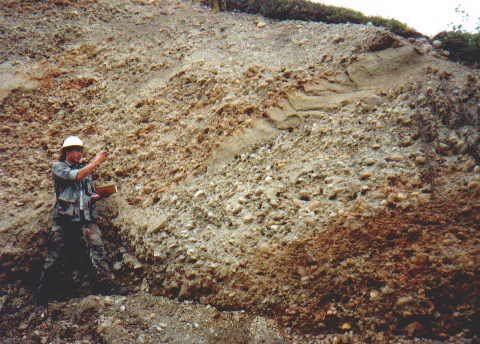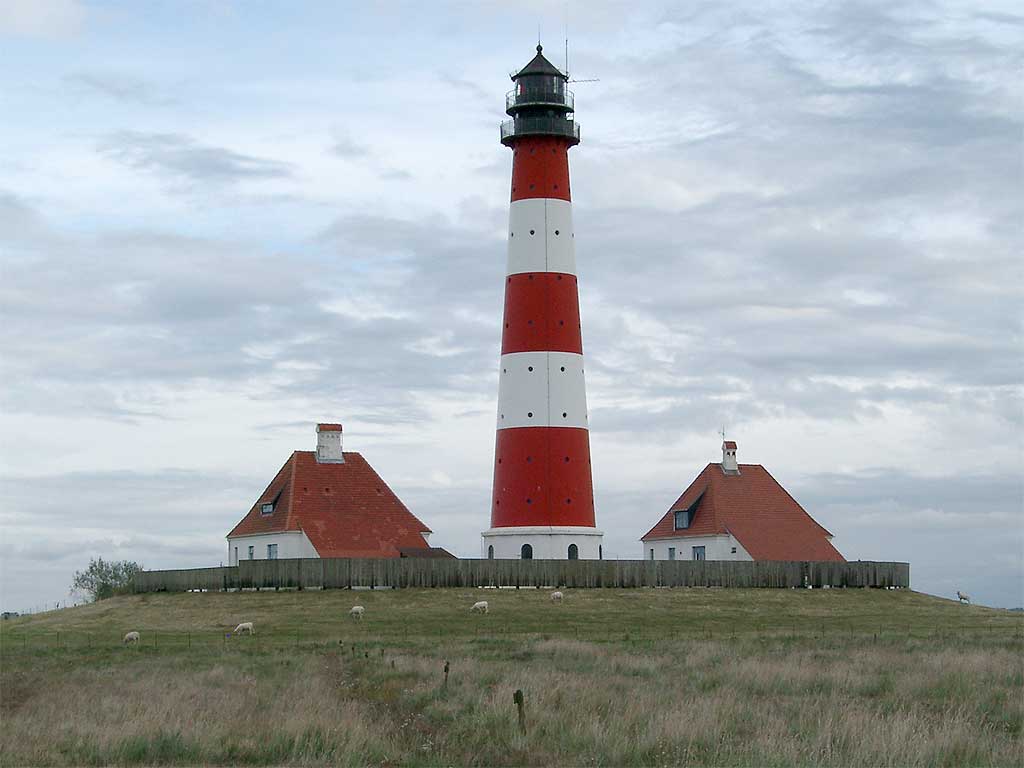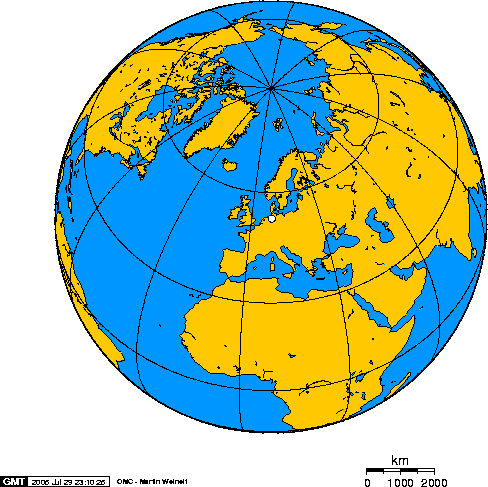|
Dunkirk Transgression
The Dunkirk transgressions were tidal bulges or other sea level-related marine transgressions (risings), often heightened by river floods, affecting the North Sea and adjoining low land. Most of this land is vulnerable to such events being below or approximately at sea level. Three events and mass evacuations, at least, are seen, some stretching to land above-sea level today. The events affected the Low Countries and other land near the German Bight, Thames Estuary and The Wash. They spanned from the late Roman period until Early Medieval Europe. Outline knowledge The exact scale of each event with notable human impact in duration, being hypothetically determined, is debated. The cause of each is also somewhat debated, however tidal bulges have been a continuing cyclical problem of the North Sea in the centuries since. Chronology The main parts of the Low Countries were lightly populated until about 200 BC, when the climate and environment became more amenable to human habitat ... [...More Info...] [...Related Items...] OR: [Wikipedia] [Google] [Baidu] |
North
North is one of the four compass points or cardinal directions. It is the opposite of south and is perpendicular to east and west. ''North'' is a noun, adjective, or adverb indicating Direction (geometry), direction or geography. Etymology The word ''north'' is etymology, related to the Old High German ''nord'', both descending from the Proto-Indo-European language, Proto-Indo-European unit *''ner-'', meaning "left; below" as north is to left when facing the rising sun. Similarly, the other cardinal directions are also related to the sun's position. The Latin word ''borealis'' comes from the Ancient Greek, Greek ''Anemoi#Boreas, boreas'' "north wind, north", which, according to Ovid, was personified as the wind-god Anemoi#Boreas, Boreas, the father of Calais and Zetes. ''Septentrionalis'' is from ''septentriones'', "the seven plow oxen", a name of ''Ursa Major''. The Greek ἀρκτικός (''arktikós'') is named for the same constellation, and is the source of the English ... [...More Info...] [...Related Items...] OR: [Wikipedia] [Google] [Baidu] |
North Brabant
North Brabant ( nl, Noord-Brabant ; Brabantian: ; ), also unofficially called Brabant, is a province in the south of the Netherlands. It borders the provinces of South Holland and Gelderland to the north, Limburg to the east, Zeeland to the west, and the Flemish provinces of Antwerp and Limburg to the south. The northern border follows the Meuse westward to its mouth in the Hollands Diep strait, part of the Rhine–Meuse–Scheldt delta. North Brabant has a population of 2,562,566 as of November 2019. Major cities in North Brabant are Eindhoven (pop. 231,642), Tilburg (pop. 217,259), Breda (pop. 183,873) and its provincial capital 's-Hertogenbosch (pop. 154,205). History The Duchy of Brabant was a state of the Holy Roman Empire established in 1183 or 1190. It developed from the Landgraviate of Brabant and formed the heart of the historic Low Countries, part of the Burgundian Netherlands from 1430 and of the Habsburg Netherlands from 1482, until it was split up after th ... [...More Info...] [...Related Items...] OR: [Wikipedia] [Google] [Baidu] |
Alluvium
Alluvium (from Latin ''alluvius'', from ''alluere'' 'to wash against') is loose clay, silt, sand, or gravel that has been deposited by running water in a stream bed, on a floodplain, in an alluvial fan or beach, or in similar settings. Alluvium is also sometimes called alluvial deposit. Alluvium is typically geologically young and is not consolidated into solid rock. Sediments deposited underwater, in seas, estuaries, lakes, or ponds, are not described as alluvium. Floodplain alluvium can be highly fertile, and supported some of the earliest human civilizations. Definitions The present consensus is that "alluvium" refers to loose sediments of all types deposited by running water in floodplains or in alluvial fans or related landforms. However, the meaning of the term has varied considerably since it was first defined in the French dictionary of Antoine Furetière, posthumously published in 1690. Drawing upon concepts from Roman law, Furetière defined ''alluvion'' (the F ... [...More Info...] [...Related Items...] OR: [Wikipedia] [Google] [Baidu] |
Carolingian Dynasty
The Carolingian dynasty (; known variously as the Carlovingians, Carolingus, Carolings, Karolinger or Karlings) was a Frankish noble family named after Charlemagne, grandson of mayor Charles Martel and a descendant of the Arnulfing and Pippinid clans of the 7th century AD. The dynasty consolidated its power in the 8th century, eventually making the offices of mayor of the palace and '' dux et princeps Francorum'' hereditary, and becoming the ''de facto'' rulers of the Franks as the real powers behind the Merovingian throne. In 751 the Merovingian dynasty which had ruled the Germanic Franks was overthrown with the consent of the Papacy and the aristocracy, and Pepin the Short, son of Martel, was crowned King of the Franks. The Carolingian dynasty reached its peak in 800 with the crowning of Charlemagne as the first Emperor of the Romans in the West in over three centuries. His death in 814 began an extended period of fragmentation of the Carolingian Empire and decline that w ... [...More Info...] [...Related Items...] OR: [Wikipedia] [Google] [Baidu] |
Nordfriesland
Nordfriesland (; da, Nordfrisland; frr, Nordfraschlönj ), also known as North Frisia, is the northernmost district of Germany, part of the state of Schleswig-Holstein. It includes almost all of traditional North Frisia (with the exception of the island of Heligoland), as well as adjacent parts of the Schleswig Geest to the east and Stapelholm to the south, and is bounded (from the east and clockwise) by the districts of Schleswig-Flensburg and Dithmarschen, the North Sea and the Danish county of South Jutland. The district is called ''Kreis Nordfriesland'' in German, ''Kreis Noordfreesland'' in Low German, ''Kris Nordfraschlönj'' in Mooring North Frisian, ''Kreis Nuurdfresklun'' in Fering North Frisian and ''Nordfrislands amt'' in Danish. As of 2008, Nordfriesland was the most visited rural district in Germany. History The sea has always had a strong influence in the region. In medieval times, storm tides made life in what is now Nordfriesland rather dangerous. Onl ... [...More Info...] [...Related Items...] OR: [Wikipedia] [Google] [Baidu] |
Eiderstedt
Eiderstedt (german: Eiderstedt, ; da, Ejdersted; North Frisian: ''Ääderstää'') is a peninsula in the district of Nordfriesland in the German federal state of Schleswig-Holstein. Overview It is approximately 30 km in length and 15 km in width and has been created through diking (polders) from three islands: Eiderstedt around Tönning, Utholm around Tating, and Evershop around Garding. The diking started around the year 1000 AD. Since these three islands were administrative districts of their own, the area was originally called ''Dreilande'' - "Three Lands". Alluvial soil won from the North Sea makes the area well-suited for agriculture. At present, tourism dominates, particularly in the city of Sankt Peter-Ording on the peninsula's western tip. The Westerhever lighthouse is the peninsula's main emblem and the most prominent lighthouse in Germany. The Wadden Sea, the Eider Barrage on the Eider River and the Katinger Watt, marshlands won from the sea in the pro ... [...More Info...] [...Related Items...] OR: [Wikipedia] [Google] [Baidu] |
Dithmarschen
Dithmarschen (, Northern Low Saxon, Low Saxon: ; archaic English: ''Ditmarsh''; da, Ditmarsken; la, label=Medieval Latin, Tedmarsgo) is a district in Schleswig-Holstein, Germany. It is bounded by (from the north and clockwise) the districts of Nordfriesland, Schleswig-Flensburg, Rendsburg-Eckernförde, and Steinburg, by the state of Lower Saxony (district of Stade (district), Stade, from which it is separated by the Elbe river), and by the North Sea. From the 13th century up to 1559 Dithmarschen was an independent peasant republic within the Holy Roman Empire and a member of the Hanseatic League. Geography The district is located on the North Sea. It is embraced by the Elbe estuary to the south and the Eider (river), Eider estuary to the north. Today it forms a kind of artificial island, surrounded by the Eider river in the north and the Kiel Canal in both the east and southeast. It is a rather flat countryside that was once full of fens and swamps. To the north it borders on ... [...More Info...] [...Related Items...] OR: [Wikipedia] [Google] [Baidu] |
Jade Estuary
The Jade Bight (or ''Jade Bay''; german: Jadebusen) is a bight or bay on the North Sea coast of Germany. It was formerly known simply as ''Jade'' or ''Jahde''. Because of the very low input of freshwater, it is classified as a bay rather than an estuary.Günther Lang, Bundesanstalt für Wasserbau (Federal Bureau for Water-Bound Constructions): ''Ein Beitrag zur Tidedynamik der Innenjade und des Jadebusens (A contribution on the tidal dynamics of Innenjade and Jadebusen)'' (in German) Intrusion of the sea About 180 km² (70 mi²) in area, the Jade was largely created by storm floods during the 13th and 16th centuries. Since the early 14th century, it has joined eastward to the estuary of the river Weser. For some time, there were three permanent connecting branches and one flood bed between the river and the bight, forming an estuarine delta. The first of these junctions was closed in 1450 by dikes and the last one in 1515. However, about a century passed before most ... [...More Info...] [...Related Items...] OR: [Wikipedia] [Google] [Baidu] |
Weser
The Weser () is a river of Lower Saxony in north-west Germany. It begins at Hannoversch Münden through the confluence of the Werra and Fulda. It passes through the Hanseatic city of Bremen. Its mouth is further north against the ports of Bremerhaven and Nordenham. The latter is on the Butjadingen Peninsula. It then merges into the North Sea via two highly saline, estuarine mouths. It connects to the canal network running east-west across the North German Plain. The river, when combined with the Werra (a dialectal form of "Weser"), is long and thus, the longest river entirely situated within Germany (the Main, however, is the longest if the Weser and Werra are not combined). The Weser itself is long. The Werra rises in Thuringia, the German state south of the main projection (tongue) of Lower Saxony. Etymology "Weser" and "Werra" are the same words in different dialects. The difference reflects the old linguistic border between Central and Low German, passing through H ... [...More Info...] [...Related Items...] OR: [Wikipedia] [Google] [Baidu] |
Friesland (district)
Friesland is a district (''Landkreis'') in Lower Saxony, Germany. It is bounded by (from the southeast and clockwise) the districts of Wesermarsch, Ammerland, Leer and Wittmund, and by the North Sea. The city of Wilhelmshaven is enclosed by—but not part of—the district. History The Frisian region was ruled by local chieftains until the 15th century; see East Frisia for details. In 1438 in the northern part of today's Landkreis Friesland the Lordship of Jever was founded. East Frisia was from then on regarded as a hostile territory, and many skirmishes between Jever and East Frisia took place during the 15th and 16th centuries. The last ruler of Jever was Mary of Jever, who ruled until 1575. After her death Jever became a part of Oldenburg, but East Frisia made a claim for the territory as well. In the following decades East Frisia tried to block all roads between Jever and Oldenburg. It was not before the 17th century that the hostilities between East Frisia and Oldenburg e ... [...More Info...] [...Related Items...] OR: [Wikipedia] [Google] [Baidu] |
East Frisia
East Frisia or East Friesland (german: Ostfriesland; ; stq, Aastfräislound) is a historic region in the northwest of Lower Saxony, Germany. It is primarily located on the western half of the East Frisian peninsula, to the east of West Frisia and to the west of Landkreis Friesland. Administratively, East Frisia consists of the districts Aurich, Leer and Wittmund and the city of Emden. It has a population of approximately 469,000 people and an area of . There is a chain of islands off the coast, called the East Frisian Islands (''Ostfriesische Inseln''). From west to east, these islands are: Borkum, Juist, Norderney, Baltrum, Langeoog and Spiekeroog. History The geographical region of East Frisia was inhabited in Paleolithic times by reindeer hunters of the Hamburg culture. Later there were Mesolithic and Neolithic settlements of various cultures. The period after prehistory can only be reconstructed from archaeological evidence. Access to the early history of East Fris ... [...More Info...] [...Related Items...] OR: [Wikipedia] [Google] [Baidu] |
Groningen (province)
Groningen (; gos, Grunn; fry, Grinslân) is the northeasternmost province of the Netherlands. It borders on Friesland to the west, Drenthe to the south, the German state of Lower Saxony to the east, and the Wadden Sea to the north. As of February 2020, Groningen had a population of 586,309 and a total area of . Historically the area was at different times part of Frisia, the Frankish Empire, the Holy Roman Empire, and the Dutch Republic, the precursor state of the modern Netherlands. In the 14th century, the city of Groningen became a member of the Hanseatic League. The provincial capital and the largest city in the province is the city of Groningen (231,299 inhabitants). Since 2016, René Paas has been the King's Commissioner in the province. A coalition of GroenLinks, the Labour Party, ChristianUnion, People's Party for Freedom and Democracy, Democrats 66, and Christian Democratic Appeal forms the executive branch. The province is divided into 10 municipalities. T ... [...More Info...] [...Related Items...] OR: [Wikipedia] [Google] [Baidu] |







